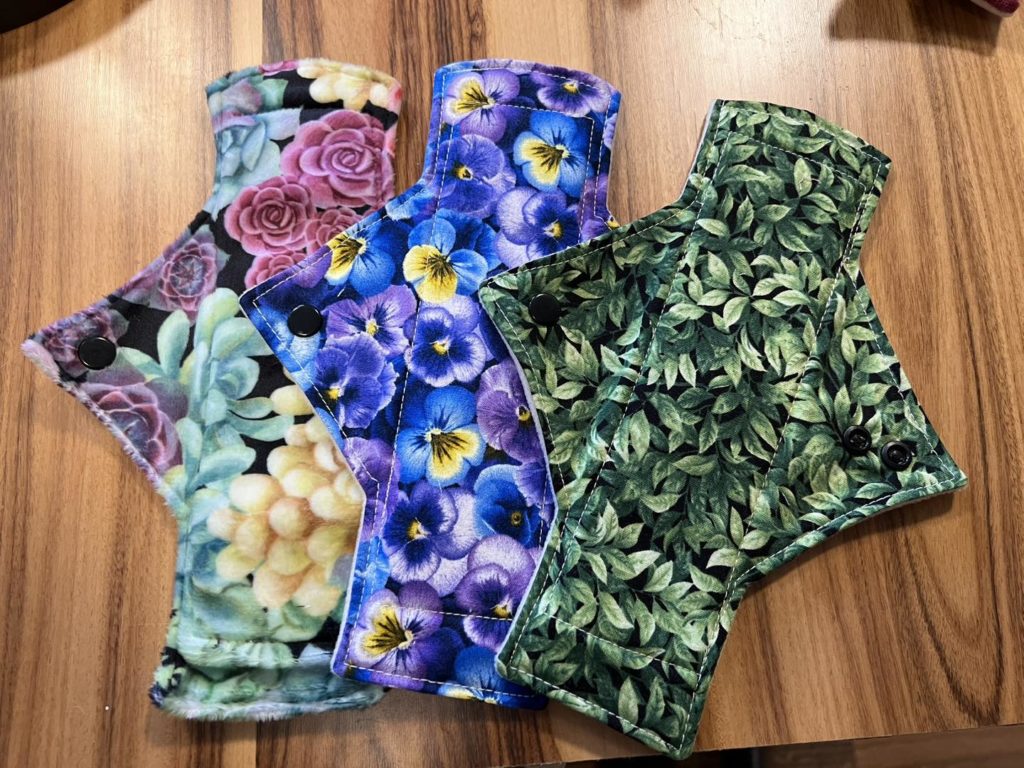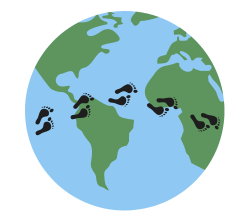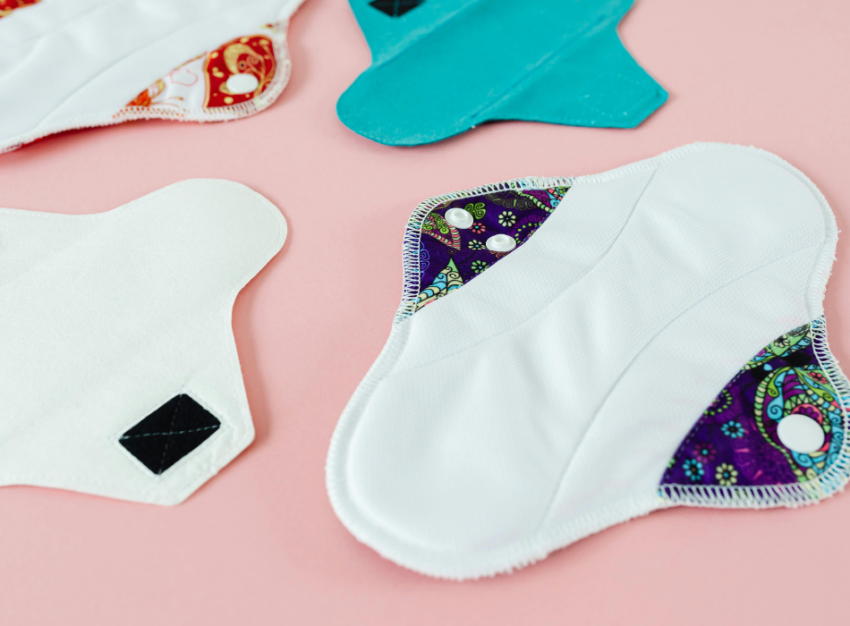Can I tell you a secret? I like to wear fun socks. Not like knee-high, neon-coloured ones. But socks with stripes, polka dots, cats and other fun patterns. This comes back to bite me when I go to the dentist and remember that I’ll need to remove my shoes.
It may not seem like the most exciting secret, but anyone who knows me well knows that I don’t normally dress in a flashy way.
This love of patterns is why I love that Tree Hugger Cloth Pads have fun designs on them like snowpeople, dandelions and bonfires. It makes a not-so-nice time of the month a bit better.
On a more-serious note, a while back, I noticed that menstrual pads were one of the bulkiest items in my bathroom garbage. However, I was reluctant to try a reusable alternative because I don’t like blood and didn’t want to have to deal with rinsing off blood.
It was only when I found out that you can just toss Tree Hugger Cloth Pads in the laundry with your other clothes that I was willing to give them a try. I’ve been using them since 2021 and haven’t looked back!
Other reasons to love Tree Hugger Cloth Pads
Here are a few more reasons you might want to try Tree Hugger Cloth Pads:
- Their pads come in different sizes and absorbencies
- Their pads are soft and fluffy (learn about the different fabric options here)
- Their products are made in Canada
- They plant a tree for every pantyliner or pad purchased
The environmental impacts of disposable menstrual products

The quantity of disposable menstrual products that are used is pretty shocking. For example, a person who menstruates disposes of more than 10,000 menstrual products over their lifetime. Just in the U.S., approximately 12 billion pads and 7 billion tampons are thrown away every year.
When menstrual products and their packaging are thrown away, they may end up in landfills, the environment or our oceans, as litter and eventually microplastics. In landfills, menstrual products take 500 to 800 years to degrade.
The plastics used in disposable menstrual products require fossil fuels for their production. And we know that the very materials in disposable pads and tampons can make us sick. These products often contain dangerous chemicals like bleach, phthalates, volatile organic compounds and PFAS, which can cause skin irritation and serious health concerns.
The financial cost of reusable pads
By contrast, reusable pads seem like a great alternative—they reduce the waste going to landfills and protect human health. Indeed, Tree Hugger Cloth Pads last for about 100 to 200 washes (around five to 10 years).
However, it’s worth noting that reusable pads are significantly more expensive. For example, Tree Hugger Cloth Pads cost about $18 each.
A couple of points related to this: reusable products are an investment, and there will be savings over time as you reuse your pads instead of constantly buying new ones. Try using Tree Hugger Cloth Pads’ savings calculator to get a sense of how much money you’ll save over the long term, plus how many disposable pads you’ll prevent from going to landfill.
As well, you don’t need to buy a full stash of reusable pads at once. As one of my colleagues would say, don’t boil the ocean. It’s okay to use a mix of reusable and disposable pads and transition gradually. Every time you prevent a disposable pad from going to landfill, that’s a good thing!
How to wear and wash reusable pads

Wearing reusable pads is very similar to wearing disposable ones. Wear the pads like normal (they often have a snap to hold them in place) and switch to a new pad when you’d normally do so. I find I need to change pads slightly more often when wearing reusable ones, but it depends on the person.
For Tree Hugger Cloth Pads specifically, you can store used pads with your other dirty laundry (or in a separate bag if you prefer), then toss them in the washer and dryer like normal. The company recommends washing the pads in cold water if possible. A couple of things to avoid: soaking the pads and using fabric softener or bleach. See full washing instructions here.
If you’re worried about stains, I can say from personal experience that hydrogen peroxide is great for removing blood stains!
Note that these instructions are specific to Tree Hugger Cloth Pads. Other brands may have different washing instructions, so be sure to check those.
Challenges with using reusable pads
I’ve shared a lot of good things about using reusable pads, but like with any new habit, there are a few adjustments. Here are a few issues I’ve had (and solutions, where possible).
Transporting reusable pads in a discreet way
Reusable pads are a bit bigger than disposable pads and harder to hide in your pocket or purse. Plus, when you’re done with your current pad, you need to carry it around until you can toss it in your laundry hamper. This doesn’t matter so much when you’re at home, but it can make things awkward when you’re at work or school or otherwise out and about.
What I’ve done so far is carry pads around in a reusable or plastic bag, but I think using something like a makeup bag would be more discreet. While doing research for this post, I also found out about wet bags, which are waterproof bags originally designed for storing cloth diapers (but also great for carrying cloth pads).
Making sure you have enough reusable pads

If you plan to use only/mainly reusable pads, you’ll need quite a few—which takes up a fair amount of space and is expensive. To figure out how many to get, think about how long your cycle is, how many pads you normally wear in a day and how often you do laundry.
I’ve seen recommendations to do laundry more often (even daily) to ensure you have enough clean pads, but this doesn’t make sense to me, given that laundry is energy- and water-intensive. Since I’m just doing laundry for myself, I always feel bad if I just do a small load.
This is one of the only cases where I’d recommend buying more of something to ensure that you have enough pads to make it through your cycle. However, you can think what makes the most sense for you in terms of number of pads versus frequency of doing laundry.
Travelling with reusable pads
Travelling with reusable pads combines both the transportation issue and the quantity issue—specifically that these pads can be bulky in your suitcase. I haven’t found a great solution for this, but Tree Hugger has some good tips for travelling with reusable pads.
Thinking about things like whether you’re likely to be on your period during your trip, what the journey to your destination will look like, where you’ll be staying, and whether you’ll have access to a washer and dryer will help you plan how many pads to bring.
Transitioning to reusable pads for a sustainable future
I hope this post has shown you some of the benefits of using reusable pads and made you feel more open to trying them (if you haven’t already).
Of course, menstruating is a personal thing, and everyone has a different experience of it. Do what makes you comfortable. For me, wearing reusable pads makes being on my period just a bit better and more sustainable. I call that a win!
I want to know: Have you used reusable pads before? What has your experience been? How have you solved the issues I’ve mentioned?
Disclaimers
Since I don’t normally do posts promoting specific products, I wanted to give a couple of disclaimers:
- I’m not being paid by Tree Hugger Cloth Pads to write this post—I just like their product.
- I haven’t tried other reusable menstrual products, so I can’t compare Tree Hugger Cloth Pads to other brands or styles of product. Learn about other options for reusable menstrual products, including menstrual cups and period underwear, in this post by the David Suzuki Foundation.
Categories and tags:
Share this post:

